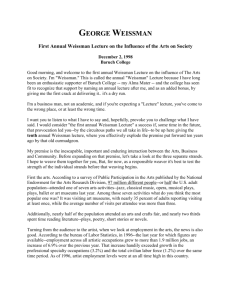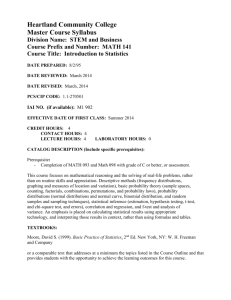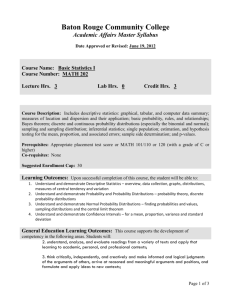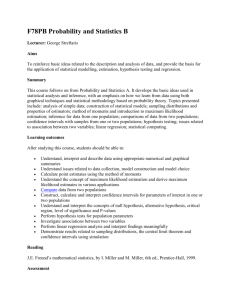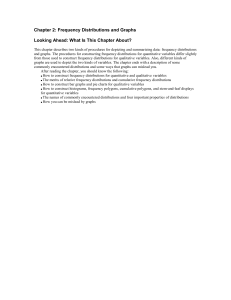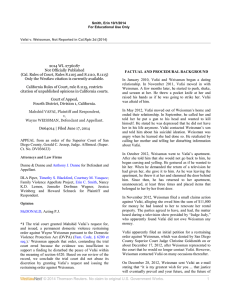MTH 101 Statistics and Probability I
advertisement
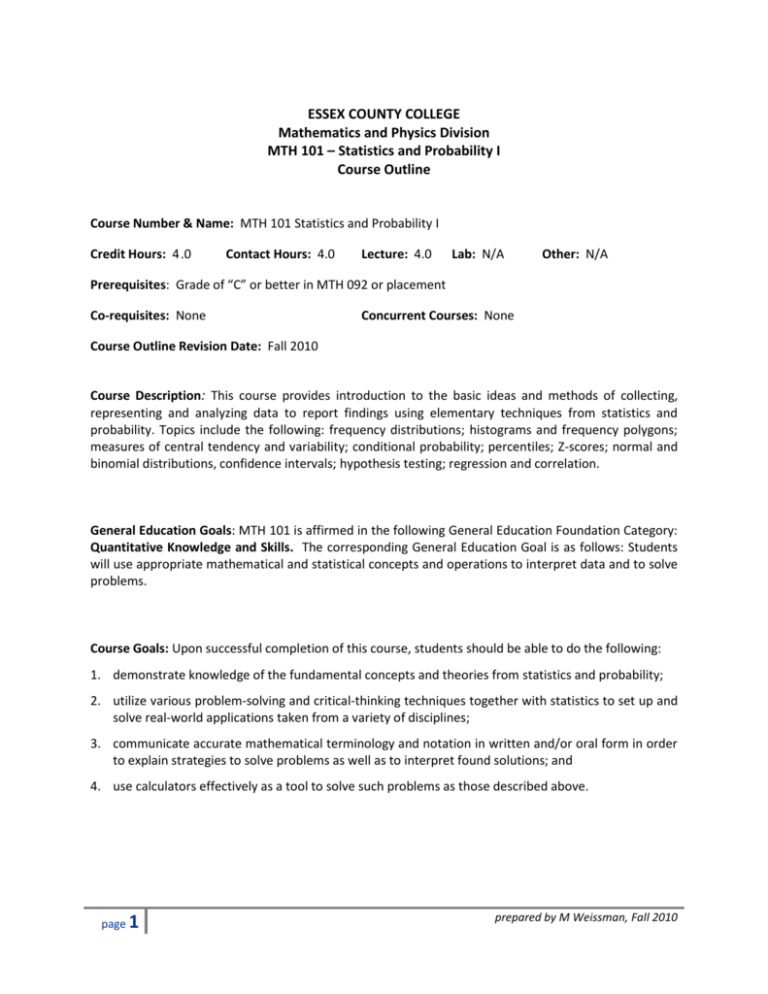
ESSEX COUNTY COLLEGE Mathematics and Physics Division MTH 101 – Statistics and Probability I Course Outline Course Number & Name: MTH 101 Statistics and Probability I Credit Hours: 4 .0 Contact Hours: 4.0 Lecture: 4.0 Lab: N/A Other: N/A Prerequisites: Grade of “C” or better in MTH 092 or placement Co-requisites: None Concurrent Courses: None Course Outline Revision Date: Fall 2010 Course Description: This course provides introduction to the basic ideas and methods of collecting, representing and analyzing data to report findings using elementary techniques from statistics and probability. Topics include the following: frequency distributions; histograms and frequency polygons; measures of central tendency and variability; conditional probability; percentiles; Z-scores; normal and binomial distributions, confidence intervals; hypothesis testing; regression and correlation. General Education Goals: MTH 101 is affirmed in the following General Education Foundation Category: Quantitative Knowledge and Skills. The corresponding General Education Goal is as follows: Students will use appropriate mathematical and statistical concepts and operations to interpret data and to solve problems. Course Goals: Upon successful completion of this course, students should be able to do the following: 1. demonstrate knowledge of the fundamental concepts and theories from statistics and probability; 2. utilize various problem-solving and critical-thinking techniques together with statistics to set up and solve real-world applications taken from a variety of disciplines; 3. communicate accurate mathematical terminology and notation in written and/or oral form in order to explain strategies to solve problems as well as to interpret found solutions; and 4. use calculators effectively as a tool to solve such problems as those described above. page 1 prepared by M Weissman, Fall 2010 Measurable Course Performance Objectives (MPOs): Upon successful completion of this course, students should specifically be able to do the following: 1. Demonstrate knowledge of the fundamental concepts and theories from statistics and probability: 1.1 use descriptive methods of statistics for the purpose of organizing and summarizing data; compute measures of center, variation and position; 1.2 construct and interpret histograms, frequency polygons, and stem-and-leaf and box plots and draw appropriate conclusions; 1.3 apply the concepts of experiments, outcomes, events, sample spaces and relative frequency to solve probability problems and construct and interpret probability distributions; 1.4 recognize, understand, and use the normal probability distribution; 1.5 use methods of inferential statistics to interpret data for the purposes of interval estimation of means and proportions, decision-making in hypothesis tests, ANOVA, and chi-square procedures; 1.6 use methods of descriptive statistics on bivariate data to assess the relationship between two variables and interpret correlation coefficients; and 1.7 use linear regression techniques for purposes of analysis and prediction 2. Utilize various problem-solving and critical-thinking techniques together with statistics to set up and solve application problems taken from a variety of disciplines: 2.1 apply statistical methods to solve varied real-world applications, such as determining whether a new drug is more effective, comparing machines for better efficiency, and assessing whether there is a relationship between two teaching methods 3. Communicate accurate mathematical terminology and notation in written and/or oral form in order to explain strategies to solve problems as well as to interpret found solutions: 3.1 conduct statistical studies (experimental or observational), including creating the sampling design, interpreting computer results from collected data, and inferring from these results a conclusion consistent with the design 4. Use calculators effectively as a tool to solve such problems as those described above: 4.1 use calculators and/or computers to calculate permutations and combinations and evaluate formulas to determine parameters such as the mean, variance, and correlation coefficient; and 4.2 use computers to construct frequency distributions, histograms, frequency polygons, and stemand-leaf and box plots and draw appropriate conclusions Methods of Instruction: Instruction will consist of a combination of lectures, class discussions, individual projects, computer lab work, small-group work, computer-assisted instruction, online computer Applets, student oral presentations, and videos and podcasts. page 2 prepared by M Weissman, Fall 2010 Outcomes Assessment: Exam and homework questions are blueprinted to course objectives. Checklist rubrics are used to evaluate projects for the presence of course objectives. Data is collected and analyzed to determine the level of student performance on these assessment instruments in regards to meeting course objectives. The results of this data analysis are used to guide necessary pedagogical and/or curricular revisions. Course Requirements: All students are required to: 1. Do homework assignments in a timely manner. 2. Take part in class discussion and doing problems on the board when required. 3. Take all in-class exams and complete all assigned projects as scheduled. Methods of Evaluation: Final course grades will be computed as follows: Grading Components % of final course grade Homework A homework folder with complete corrected solutions to problems assigned throughout the semester will indicate the extent to which students have mastered course objectives. 0 – 10% 6 or more Tests (dates specified by the instructor) Tests will show evidence of the extent to which students meet course objectives including, but not limited to, analyzing and solving problems, estimating and interpreting results, and stating appropriate conclusions using correct terminology. 70 – 80% 6 or more Projects (dates specified by the instructor) Projects place emphasis on student experiences to enhance the lessons presented in the class. Projects will indicate how well students collect, record, describe real life data and apply techniques discussed in class to infer from that data. Use of technology will be required. Projects will be assessed for student mastery of course objectives. 15 –20% NOTE: The instructor will provide specific weights, which lie in the above-given ranges, for each of the grading components at the beginning of the semester. page 3 prepared by M Weissman, Fall 2010 Academic Integrity: Dishonesty disrupts the search for truth that is inherent in the learning process and so devalues the purpose and the mission of the College. Academic dishonesty includes, but is not limited to, the following: plagiarism – the failure to acknowledge another writer’s words or ideas or to give proper credit to sources of information; cheating – knowingly obtaining or giving unauthorized information on any test/exam or any other academic assignment; interference – any interruption of the academic process that prevents others from the proper engagement in learning or teaching; and fraud – any act or instance of willful deceit or trickery. Violations of academic integrity will be dealt with by imposing appropriate sanctions. Sanctions for acts of academic dishonesty could include the resubmission of an assignment, failure of the test/exam, failure in the course, probation, suspension from the College, and even expulsion from the College. Student Code of Conduct: All students are expected to conduct themselves as responsible and considerate adults who respect the rights of others. Disruptive behavior will not be tolerated. All students are also expected to attend and be on time all class meetings. No cell phones or similar electronic devices are permitted in class. Please refer to the Essex County College student handbook, Lifeline, for more specific information about the College’s Code of Conduct and attendance requirements. page 4 prepared by M Weissman, Fall 2010 Course Content Outline: based on the text Elementary Statistics: A Brief Version, 5th edition, by Allan G Bluman; published by McGraw-Hill, 2010; ISBN-13 #: 978-0-07-338609-6 Class Meeting (80 minutes) Chapter/Section CHAPTER 1 THE NATURE OF PROBABILITY AND STATISTICS Assigned as outside reading for background and establishing context CHAPTER 2 FREQUENCY DISTRIBUTIONS AND GRAPHS 2.1 Organizing Data 2.2 Histograms, Frequency Polygons, and Ogives 2.3 Other Types of Graphs p 76 Misleading Graphs p 80 Stem & Leaf Plots 1 2 3 4 Project #1 presentations 5 6 7 8 CHAPTER 3 DATA DESCRIPTION 3.1 Measures of Central Tendency 3.2 Measures of Variation 3.3 Measures of Position 3.4 Exploratory Data Analysis 9 10 Project #2 presentations Test #1 on Chapters 1, 2 & 3 CHAPTER4 PROBABILITY AND COUNTING RULES 4.1 Sample Spaces and Probability 4.2 The Addition Rules for Probability 4.3 The Multiplication Rules and Conditional Probability 4.4 Counting Rules 4.5 Probability and Counting Rules 11 12 13 14 15 16 CHAPTER 5 DISCRETE PROBABILITY DISTRIBUTIONS 5.1 Probability Distributions 5.2 Mean, Variance, Standard Deviation and Expectation 5.3 The Binomial Distribution 17 18 Project #3 presentations Test #2 on Chapters 4 & 5 page 5 prepared by M Weissman, Fall 2010 Class Meeting (80 minutes) Chapter/Section 19 20 21 22 CHAPTER 6 THE NORMAL DISTRIBUTION 6.1 Normal Distributions 6.2 Applications of the Normal Distribution 6.3 The Central Limit Theorem 6.4 Normal Approximation to Binomial Distribution 23 24 Project #4 presentations Test #3 on Chapter 6 25 27 CHAPTER 7 CONFIDENCE INTERVALS AND SAMPLE SIZE 7.1–7.2 Confidence Intervals for the Mean 7.3 Confidence Intervals for Proportions 7.4 Confidence Intervals for Variances and Standard Deviations 28 Test #4 on Chapter 7 29 30 31 CHAPTER 8 HYPOTHESIS TESTING 8.1 Steps in Hypothesis Testing 8.2 z Test for a Mean 8.3 t Test for a Mean 32 33 Project #5 presentations Test #5 on Chapter 8 34-35 36 CHAPTER 10 CORRELATION AND REGRESSION 10.1 Correlation 10.2 Regression 37 Project #6 presentations 38-39 40 41 CHAPTER 11 CHI-SQUARE AND ANOVA 11.1 Test for Goodness of Fit 11.2 Tests using Contingency Tables 11.3 Analysis of Variance (ANOVA) 42 Test #6 on Chapters 10 & 11 page 6 prepared by M Weissman, Fall 2010 MTH 101 – Suggested Homework Problems TEXT: Elementary Statistics: A Brief Version, 5th edition, by Allan G. Bluman; published by McGrawHill, 2010 Section Ch 1 2.1 2.2 2.3 3.1 3.2 3.3 3.4 4.1* 4.2* 4.3* 4.4* 4.5* 5.1* 5.2* 5.3 6.1 6.2 6.3 6.4 7.1 7.2 7.3* 7.4* 8.1 8.2 8.3 10.1 10.2 11.1 11.2 11.3* Homework page and numbers________________________________________ read the entire chapter p 46 # 1,2,3,4,5,8,9,10,11,12,13,14,15 p 61 # 1,2,3,5,6,7,13,15,16 p 84 # 15,16,17,18,19 p 126 # 1,3,5,7,8,9,12,13,14,15,19,21,32,33,34 p 145 # 1,2,3,4,5,6,7,8,9,11,13,16,28,31 p 161 # 1,2,3,4,5,6,7,8,9,10,11,13,15,22,23,24,25,26,27,30 p 174 # 1,3,5,7,9,12,13,14 p 203 # 1–15,17,19,21,25,27,31,34 p 212 # 1,2,3,5,7,9,11,13,15 p 228 # 1,3,5,7,9,11,13,15,17 p 241 # 13abcd, 18,27,31,32,33,34 p 248 # 1,3,5,7,9,11,13 p 266 # 1,2,3,4,5,7,9,11,13,15,17,19,21 p 275 # 1,3,5,7,9,11,13,15 p 285 # 1,2,3,4,5,6,7,8,9,10,11,13,15,17,19,21,23,25,27 p 309 # 1,2,3,4,5,6,7,8,9,10,11,13,15,17,19,21,23,25,27,29,31,33,35,37,39, 40,41,42,43,44,45,46,47,48,49 p 323 # 1,3,5,7,9,11,13,15,17,19,21,23,25,27,29,31 p 336 # 1,2,3,4,5,6,7,9,11,13,15,17,19,21,23,25 p 344 # 1,2,3,5,7,8,9,11,13 p 364 # 1,2,4,6,7,8,9,11,12,13,14,15,16,17,19,21,23,24,25 p 372 # 1,2,4,6,7,8,9,11,12,13,14,15,16,17,19 p 380 # 1,3,5,7,9,11,13,15 p 388 # 1,3,5,7,9,11 p 410 # 1,2,3,4,5,6,7,8,9,10,11,12,13 p 420 # 1,2,3,4,5,6,7,8,9,10,11,12,13 p 432 # 1,2,3,5,6,7,8,9,10,11,12,13,14,15,16,17,18,20 p 541 # 1,2,3,4,5,6,7,8,9,10,11,13,14,16,17,20 p 549 # 1,2,3,4,5,6,7,8,9,10,11,13,14,16,17,20,23,29,33,35 p 581 # 2,3,5,6,7,8,9,10,11,12,13,14,15,16,17 p 595 # 1,2,3,4,5,8,13,15,16,18,19 p 608 # 1–7,9,11,13,15 *optional, if time permits page 7 prepared by M Weissman, Fall 2010




